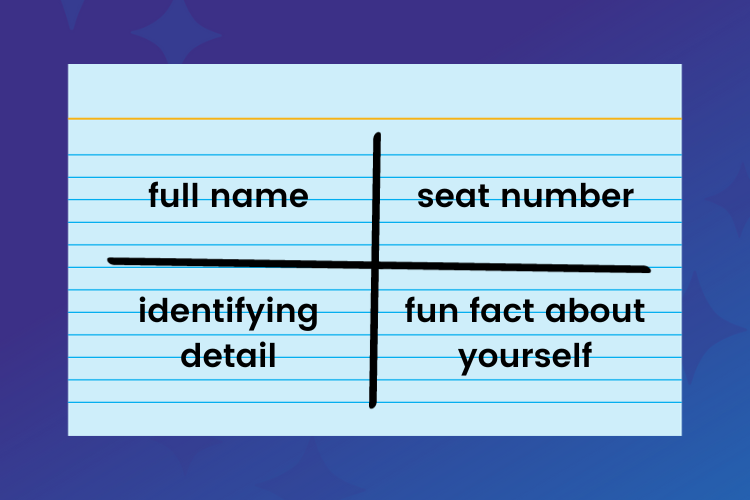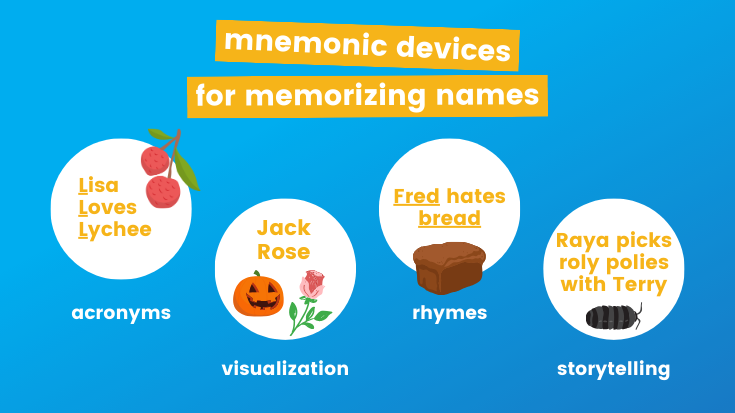Search
Get started
Log into your referral dashboard
Like our sub Geo says, “Names can be tough. Four periods, each class. Each period has 20 to 30 students. Well over a 100 students. So learning their names, asking about themselves is key.”
View this post on Instagram
Getting to know your students is a sub tip that will always help you connect with your students. It not only helps you remember names, but shows that you care!
But here are 7 more strategies for memorizing 100+ names really quickly.
1. Use name tents
Source: Emily’s World
Ask students to write their names in large letters on both sides of a folded paper and to keep this card on their desks for you to spot.
Consider asking them to write 3 fun facts about themselves on the back of their name tent for their neighbors and you to see.
2. Use flashcards for each student
When you meet the class for the first time, hand out index cards to each student. Then, ask students to draw a horizontal and vertical line to divide the card into four sections.
Post an example card on the board and ask them to fill out these sections of the index card:
- Top left: Full name
- Ask students to write their full name or a preferred version of their name. Set guidelines for nicknames in class (e.g. shortened names are OK, but invite them to correct pronunciation.
- Top right: Seat number
- If your class has seat numbers or if your teacher provides you with a seating chart, ask them to write that.
- Bottom left: One identifying detail
- Ask for a distinctive, unchanging detail to help recognize each student. Encourage details like hairstyles or accessories while being mindful of potential sensitivities.
- Bottom right: Fun fact about themselves
- Respect confidentiality and encourage both significant and casual details (e.g. “I’m on the varsity basketball team. OR I can pen spin for hours).
After collecting the cards, use them to call on students randomly, review them quietly, and challenge yourself to recall their names. This tip comes from teacher and author Roxanna Elden.
3. Annotate your roster
When checking for attendance, spend a few extra seconds for each student to identify his or her most 1-2 outstanding physical features or other noticeable traits.
Be sure to include ways of pronouncing names that are unfamiliar to you.
4. Learn a few names at a time
Use the time just before and after class to learn 5-10 names per class.
Or prioritize talking to a different group of five students each day you’re in that class assignment. Try asking them:
- What did they do on the weekend?
- What do they like to do after school?
- What’s their favorite book, show, or song? Why?
- What’s their least favorite ice cream flavor?
This helps you build relationships with students quickly. It shows you are interested in them as people!
5. Use mnemonics
Create connections between a student’s name and something unique about them. This could be a physical feature or a quality about them.
Even better if you can make it rhyme (e.g. Fred hates banana bread) or make the first letter match their first name (e.g. Lisa likes Lychee).
6. Ask students to write something about themselves
If your students are a bit shy or resistant to chatting, try assigning short personal writing prompts. Then practice names (”Well done, Sasha”) as they return papers.
- What is your favorite thing about your routine each day? Describe it and explain what makes it so fun for you!
- Write about a time you stood up for someone or helped someone and it made you really happy!
- You are responsible for creating a whole new city – what would your city be like?
You’ll learn so much about your students–how they think and how they would respond to hypothetical situations.
7. Greet students by name as they enter the classroom
Get to know your kids by knowing their names! They’ll begin to trust you.
You’ll also get good practice at pronouncing everyone’s names–especially difficult ones!
One important disclaimer
You can use these tricks to make it easier and faster to learn names. But remember, it’s ok if it doesn’t happen on the first day. In any case, just try your best and impress the kids if you can.
Want to sub with us?
With these tips, you’re sure to become a favorite sub! If you’re a current sub or someone looking to try out teaching, apply to Scoot Education.
We’re an educational staffing company dedicated to creating exceptional experiences in education.
As a Scoot sub, you’ll get ultimate flexibility in your work schedule, 1-on-1 support through a personal Education Consultant, and market leading pay.









![How to write a strong substitute note [+free template!]](https://scoot.education/wp-content/uploads/2022/05/thank-you-426x235.png)


